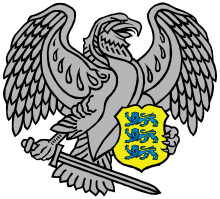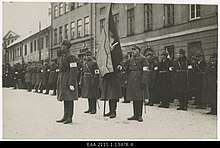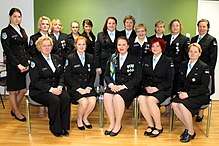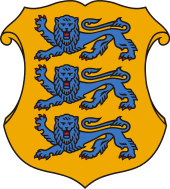Estonian Defence League
The Estonian Defence League (Estonian: Eesti Kaitseliit) is the name of the unified paramilitary armed forces of the Republic of Estonia. The Defence League is a paramilitary defence organization whose aim is to guarantee the preservation of the independence and sovereignty of the state, the integrity of its land area and its constitutional order.
| Estonian Defence League | |
|---|---|
| Eesti Kaitseliit | |
 | |
| Active | 1918–1940, 1990–present |
| Country | |
| Type | Paramilitary force |
| Size | Total: 25,968 (2017) Active members: 15,218 (2017)[1] |
| Anniversaries | 11 November (formed) 17 February (restored) |
| Engagements | Estonian War of Independence |
| Commanders | |
| Commander | Brigadier general Riho Ühtegi[2] |
| Chief of Staff | Colonel Jaak Mee |
The Defence League possesses arms and engages in military exercises, fulfilling the tasks given to it by the law. The organization is divided into 4 Territorial Defence Districts that consist of 15 Defence League regional units, called malevs, whose areas of responsibility mostly coincide with the borders of Estonian counties.
Mission
_2010.jpg)
The Defence League is a voluntary military national defence organisation, which acts in the area of government of the Ministry of Defence. The Defence League possesses arms and engages in military exercises. The main goal of the Defence League is, on the basis of the citizens’ free will and initiative, to enhance the readiness of the nation to defend its independence and its constitutional order, including in the event of military threat.
The Defence League plays an important role in supporting the civil structures. Its members aid in putting out wildfires, volunteer as assistant police members, and ensure safety at various events. Units, consisting of voluntary members of the Defence League, also participate in international peace support operations such as in the Balkan states. The Defence League and its affiliated organisations have positive relations with partner organisations in the Nordic countries, the United States, and the United Kingdom.
History


- 1918 – The Estonian Defence League was preceded by Estonia's first armed home defence organisation: Omakaitse the Citizens' Defence Organisation (German Bürgerwehr) against the public disorder accompanying the Russian Revolution.
- 1918 – On 11 November the Citizens' Defence Organisation was renamed the Estonian Defence League which performed the tasks of a national guard in the War of Independence.
- 1924 – The attempted Communist coup on December 1 dispelled any doubts about the necessity for the Defence League. Development of the Defence League for the performance of tasks of national defence was started.
- 1925 – In October the Estonian Defence League magazine "Kaitse Kodu!" ("Defend Your Home!") was founded.
- 1926 – On 19–20 June the first Estonian Defence League Festival took place in Tallinn, to be followed by six more such events held before 1940.
- 1927 – To develop the Defence League and give it a family dimension, the Commander of the Defence League approved the temporary statutes of the Women's Home Defence.
- 1928 – The Body of Elders decided to invite the boy scout organisation the Young Eagles to join the Defence League.
- 1931 – The Government of the Republic approved the Statutes of the Defence League which have remained in force until the present day.
- 1932 – The Girl Scout organisation Home Daughters was established at the Women's Home Defence.
- 1934 – To regulate the life and work of the organisation, House Rules of the Defence League were adopted.
- 1940 – With the Soviet occupation starting from 17 June, the liquidation of both the Republic of Estonia and the Defence League started.
- 1974 – Defence League in exile was founded by Avdy Andresson, Estonian Minister of War in exile.
- 1990 – The Defence League was re-founded on 17 February at Järvakandi on popular initiative in order to defend Estonia's independent statehood.
- 1991 – On 4 September the Presidium of the Supreme Council of the Republic of Estonia reinstated the rights of the Defence League as a legal organization, days after its personnel were deployed as the Soviet Airborne Troops occupied the Tallinn TV Tower but owing to EDL personnel deployed to the signal rooms, did not disrupt the radio broadcasts.
- 1992 – On 28 April the Defence League was included in the Defence Forces as a national defence organisation.
In 1999 the Estonian Parliament adopted the EDL Law, which provided the position of the Kaitseliit in society and national defence and also described its main tasks, structure, legal basis for operations and control and co-operation with the Defence Forces, Police, and other state organizations.
Organization
The organisation is divided into 4 Territorial Defence Districts (maakaitseringkond) that consist of 15 Defence League regional units (malev) whose areas of responsibility mostly coincide with the borders of Estonia’s counties.[4]
- Northern Territorial Defence District: Tallinn, Harju and Rapla malevs
- Northeastern Territorial Defence District: Alutaguse, Viru, Jõgeva and Järva malevs
- Southern Territorial Defence District: Põlva, Sakala, Tartu, Valgamaa and Võrumaa malevs
- Western Territorial Defence District: Pärnumaa, Lääne and Saaremaa malevs
Today, the Defence League has over 15,000 reservists. The affiliated organisations of the Defence League combine more than 25,000 volunteers, in all, and include the Estonian Defence League’s women’s corps Naiskodukaitse, the Estonian Defence League’s boys’ corps Noored Kotkad, and the Estonian Defence League’s girls’ corps Kodutütred.
Subunits – youth and women's corps

- Defence League’s women’s corps – "Women's Home Defence"
The Defence League's women's corps – Naiskodukaitse is a support organisation of Kaitseliit. The main functions of the women’s corps include the following:
• to assist the Defence League in defending the independence of Estonia and its constitutional order, to ensure the safety of its citizens, and to discharge any other functions;
• to organise and ensure the medical and rear services of the Defence League in co-operation with the regional units;
• to promote the ideals of the Defence League and national feelings;
• to participate in organising the social life of the Defence League.
- Defence League’s girls’ corps – "Home Daughters"
The Defence League’s girls’ corps – Kodutütred was established to increase patriotic feelings and readiness to defend the independence of Estonia among young girls; to enhance the love for home and fatherland; to encourage respect for the Estonian language and ways of thinking; to be honest, enterprising, responsible, and capable of decision-making; to respect nature; and to respect one’s parents and others.
- Defence League’s boys’ corps – "Young Eagles"
The Defence League’s boys’ corps – Noored Kotkad. The objective of the organisation is to raise these young people as good citizens with healthy bodies and minds. In addition to numerous interesting activities, such as parachute jumping, flying gliders, orienteering, shooting weapons, etc., the boys’ corps also participates in numerous events, the most popular but also the most difficult being the Mini-Erna 35 km reconnaissance competition.
Culture

The Estonian Victory Day (1919) has been celebrated until WWII with military parades, organized by the Kaitseliit. Since 2000, Victory Day parades have been organized by Kaitseliit again every June 23. The 2015 parade also saw a rising number of military contingents from NATO countries take part: Latvia, the United States, Finland, Poland and Sweden, while 2016, aside from the US and Latvian troops also featured new contingents from Lithuania and Denmark.
In 2006, the first Fleet Review in Estonian history was conducted by Kaitseliit in June in Saaremaa.
In 2016, the Sakala subdivision of Estonian Defence League formed the first Estonian military pipe band and their first performance was during the yearly Victory Day parade the same year.[5][6] Band uses 4 sets of drums and 12 special sets of "war pipes"[5] made by Andres Taul.[5][7] Idea for such a unit originally came from President Lennart Meri in 2001 whilst he was visiting the Viljandi Folk Music Festival.[5][7] The idea was later revived by President Toomas Hendrik Ilves in 2010 and Ando Kiviberg, notable local piper and head of Viljandi's folk festival, was assigned to form the band.[5][7] According to Kiviberg one of the goals of the band is also to promote bagpipes amongst males, as Estonia is lacking male pipers.[5][6][7]
Personnel
Leadership
The Commander of Defence League is the highest-ranking officer of the Defence League; though he may not be the senior officer by time in grade. The Commander has the responsibility to man, training, equip and develop the organization. He does not serve as a direct battlefield commander. The Commander is a member and head of the Chief of Staff which is the main organizational tool of the Commander. The Commander is appointed by the Commander of the Defence Forces or by the Supreme Commander in Chief of the Defence Forces.[8] The current Commandant is Brigadier general Riho Ühtegi, who assumed the position in 2019. As of 2018, Colonel Jaak Mee is the Defence League Chief of Staff.[9]
Ranks and insignia
The rank structure of the Estonian Defence League corresponds to that of the rest of the Estonian Defence Forces, usually the same insignia are used correspondingly. However, sometimes specific insignia denoting positions are used by staff.
| Higher and staff positions | Senior field positions | Junior field positions | |||||||||
|---|---|---|---|---|---|---|---|---|---|---|---|
| Estonian: Ametikohad | Kaitseliidu ülem | Kaitseliidu Peastaabi ülem | Kaitseliidu maleva pealik | Maleva vaneminstruktor | Malevkonna pealik | Kompanii pealik | Rühma pealik | Rühmapealik eriüksustes | Rühmapealiku abi | Jaopealik | Jaopealiku abi |
| English: Positions | Commander | Chief of Staff | Chief of Malev | Senior instructor | Chief of Malevkond | Chief of Company | Platoon commander | Platoon commander in special forces | Assistant platoon commander | Section commander | Assistant section commander |
Uniforms
Standard uniforms of the Estonian Defence Forces are the ESTDCU issued to Defence League personnel. On some festive occasions (such as parades), white armbands with the insignia of the given territorial unit are worn. Civilian uniforms are worn by the women's division during parades and ceremonies.
Armbands have also previously been worn on civilian clothing to distinguish members of the Defence League from civilians during periods when Defence League units did not have sufficient inventories to supply every member with a uniform (during World War I; and in the beginning of the 1990s).
Equipment
.jpg)
The basic infantry weapon of the Defence League is the 5.56mm LMT R-20 RAHE, but a majority of soldiers are equipped with the IMI Galil or the 7.62mm G3 rifle. Modified U.S. M14 rifles are used by sharpshooters. The Galil rifle is being phased out in favour of the R-20 RAHE.
Suppressive fire is provided by the Ksp 58 and MG3 machine guns at the section, troop and company levels. In addition, indirect fire is provided by the 40mm M-69 antitank weapons, and 82mm B-300 grenade launchers as well as B455 81 mm mortar in battalions.
Some battlegroups also include an anti-tank units equipped with the 84mm Carl Gustav recoilless rifles and 90mm Pvpj 1110 anti-tank guns.[10] The Defence League utilizes a variety of tactical transport vehicles and a small number of armoured personnel carriers, including the BTR-80, and some old Swedish armoured cars.[11]
See also
References
- "Kaitseliidu majandusaasta aruanne 2017" (PDF). www.kaitseliit.ee (in Estonian). p. 10. Retrieved 16 July 2018.
- "Defence League to receive new Commander". www.kaitseministeerium.ee. 18 July 2019.
- History of the Defence League Archived 2011-07-22 at the Wayback Machine at www.mil.ee
- "Maakaitseringkonnad - mida sa neist teadma peaksid" (in Estonian). Kaitse Kodu!.
- Ivar Jõesaar (October 2016). "Sõjatorupilli saamislugu: nüüd, kui Eesti torupill on astunud riigikaitseteenistusse" (in Estonian). Delfi. Retrieved 22 October 2016.
- "Võidupüha paraad Võrus: pärast Ilvese kõnet toovad tunnustatud noorkotkad ja kodutütred pühadetule kõigisse maakondadesse" (in Estonian). Eesti Rahvusringhääling. 23 July 2016. Retrieved 2 June 2017.
- Raba, Rannar (23 July 2016). "Viljandi mehed viisid võidupüha paraadil Lennart Meri mõtte ellu" (in Estonian). Sakala. Retrieved 2 June 2017.
- Estonian Defence league: The leadership Archived 2011-07-20 at the Wayback Machine
- "Chief of Staff". EDL. Retrieved 2018-12-05.
- Estonian Defence League: Equipment Archived 2011-07-20 at the Wayback Machine
- "Defence League's Harju malev: Equipment of the Rävala malevkond". Archived from the original on 2009-03-31. Retrieved 2009-09-05.
External links
- Estonian Defence League, official webpage
- Estonian Defence League School
- Estonian Defence League Girl's corp, official page in Estonian
- Estonian Defence League Women's corp, official page in English
- Estonian Defence League Boy's corp, official page in Estonian
